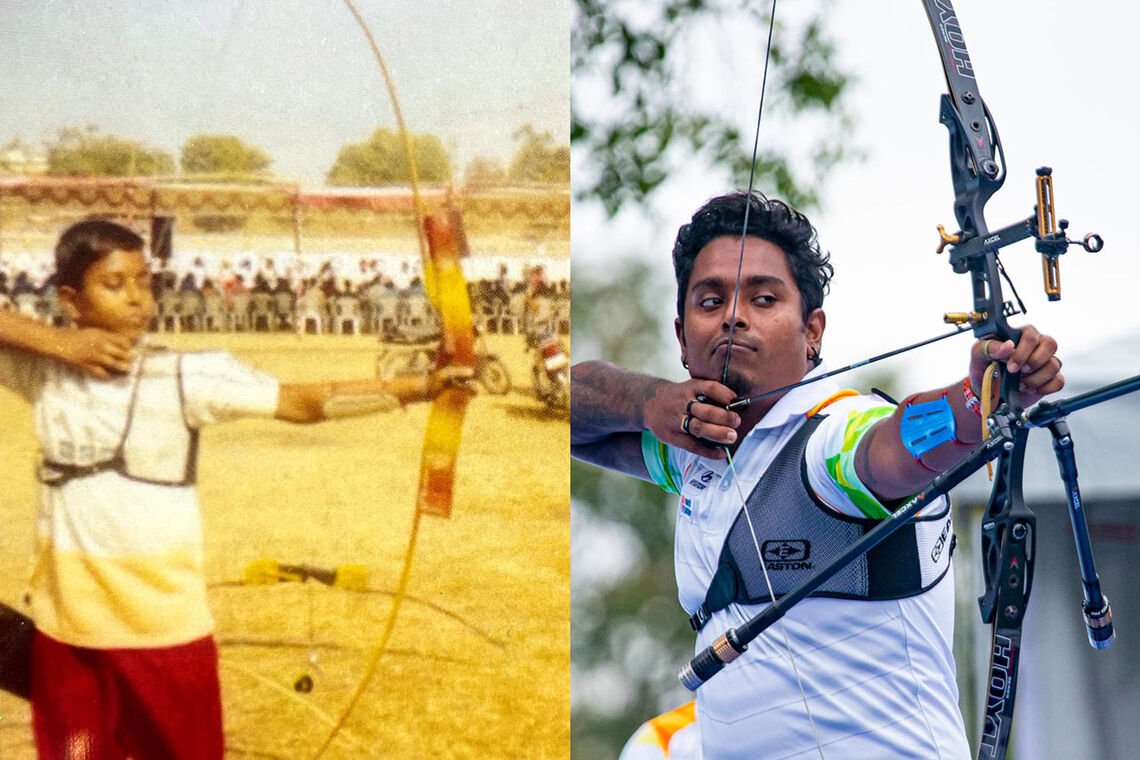Why most archers in India shoot bamboo bows that look modern

Archery couple Deepika Kumari and Atanu Das get nostalgic when they remember their early days of playing the sport. The emotion is obvious as they speak of shooting with traditional bamboo bows and arrows in a format known nationally as the Indian round.
“Those were good old days,” explains Das, the two-time Olympian who started his journey in the sport at the Calcutta Archery Club in 2006. “Shooting with the bamboo bow was a lot of fun. It was tricky, too, as the arrows’ condition changed with the weather. But I enjoyed playing with it.”
The Indian round is a combination of both equipment and competition rules – archers use bows made from bamboo but that resemble modern equipment, with stabilisers and sights, and shoot at generally closer distances. The Indian round for adults, for example, uses 50 and 30 metres.
Das competed in two national championships as a youth archer shooting the format – which is recognised and regulated by the national federation – before he moved on to more international-style competitions. He still cherishes those experiences. Kumari practised with a bamboo bow for almost a year at the Saraikela-Kharsawan Archery Association in Jharkhand, a state in eastern India. Both she and Das enrolled in the Tata Archery Academy in Jamshedpur in 2008.
“Training used to be funny. For instance, if you have three arrows and you aim at the inner yellow circle, all three arrows will hit in different positions,” recounts Kumari, before emphasising the most important feature of the traditional bamboo bow – its light poundage. The more manageable draw weight has helped hosts of archers in India master their technique.
“The smooth poundage is a factor that I love,” says Komalika Bari, a youth world champion and an international colleague of Kumari’s in recent seasons.
Top archers from across India all have the same affection for the Indian round. It has, after all, provided the basis for their contemporary skills.

The origin
Affordable and available, the Indian round and its bamboo bows are the foundation for aspiring athletes from all over the country. It has made the sport especially accessible to those from less-affluent backgrounds or originating in more tribal areas.
The secretary general of the Indian archery association, Pramod Chandurkar, was one of the founders of the Indian round when it was thought up in 1989.
Created because of its low-cost factor and the difficulty many archers had importing recurve equipment from overseas, Chandukar said the Indian round served two key purposes. It allowed athletes access to equipment while preserving some of the country’s long history with the sport.
“During the 1980s, archery equipment used to be imported from USA or Korea and India’s import policies weren’t very smooth then. It used to take months to transfer things and the costs were way too high,” he explains.
“The players would suffer due to the long wait. The basic idea behind introducing the Indian round was to offer players equipment at a low cost and easily accessible. The traditional bamboo bows served these purposes. At the same time, the traditional sport is also preserved and its players, the archers of the tribal regions of the country, promoted.”
It was a solution to a problem that was holding back Indian archery’s long-term growth.
“We thought if Indian archery has to be developed, this issue needed to be addressed soon,” says Chandukar.
The round was born out of a visit to the polo grounds in Shillong, Meghalaya, one of the seven north-eastern states of India, where the former coach was posted during training for the Indian army’s sports company under the Sports Authority of India, which is responsible for developing the country’s elite sportspeople.
“I witnessed a bunch of around 20 local archers hitting arrows at a small target. They were using traditional bamboo bows and arrows and I was amazed to see the flexibility and quantity of arrows they were hitting,” recalls Chandurkar.
“It was when the idea struck, why not customise these wooden traditional bows to our players’ requirements?”
Bamboo is not only cheap but, for 1000s of years, had proven an effective – and flexible – material for manufacturing bows.

The history
The idea was to translate the tribal approach to making traditional bamboo bows and arrows towards a more modern technique and design.
Traditional bows and arrows in India are made from specific species of bamboo found only in the northeast of the country, in states such as Meghalaya and Manipur. The best quality bows, people say, are carved from the bamboo found in the treacherous terrain and hills of Manipur. The raw materials for the best arrows, meanwhile, are collected from the Koubru slopes of Manipur and Meghalaya.
There is a deep cultural heritage attached to the making of the bamboo bow and arrow. The Meetei community in Manipur is renowned for its ability as bowyers, while the Tensubam clan has mastered the skill of fletchers.
While a modern bow set-up can cost upwards of 1500 USD, a bamboo bow costs around 12 USD – or 1000 Indian rupees.
“This was serving the mission of developing the sport across India,” says Chandukar. “Besides, it could be produced in the country, something our local archers could afford.”
A proposal was sent to the Indian archery association in 1988 or 1989 to formalise the idea – it didn’t take long for the concept to catch on. The equipment and accompanying competition formats were soon given that patriotic name and in 1997, the Indian round made its debut at the national championships.
Chandukar admits that the accuracy of the bamboo bows doesn’t match that of modern equipment.
“But it is still preferred across the country for providing a strong base among archery,” he says. “Thanks to the Indian round, the Indian archery association has been able to promote its mission of, ‘har ghar archery, har gaon archery’.”
Archery in every home, archery in every village.

Legacy
Archery coach and international sports commentator Pankaj Athawale has been trading in bamboo archery equipment from Manipur, Rajasthan and Kolkata for his TS Academy in Thane, Maharashtra since 2017. He welcomes about 50 new students every year, with many of them already having excelled in district-level competitions.
“Almost every archer in the country starts playing the game with the Indian round,” he says. “A draw weight of a modern recurve bow will ideally be around 40 pounds while the Indian round bow will require a force of only 18 to 20 pounds. An archer gets conditions with the Indian round before eventually switching to recurve or compound archery.”
People in India have a strong cultural link with the sport owing to its prevalence in mythology and ancient history.
“Archery is a sport that people from all walks of life want to learn. I have school and college students, working professionals, elderly persons who want to learn the skills more than competing, besides those who want to make a career of it,” says Athawale. The Indian round facilitates participation at every level.
There are currently around 30 manufacturers of bamboo bows and arrows across India.
Chandukar owns an equipment manufacturing company called Ruth India, which was launched in 2001 and specialises in the equipment he helped develop more than 30 years ago. It is the second-oldest manufacturer to sell Indian round gear after Manipur’s Chouba Singh. Chandukar now has buyers not just from India – but overseas, too.
Prices for a full set range from around 60 USD to 1200 USD. (There is always demand at the higher end, too.) The cost of one arrow can be just 1 USD.
The appetite for major international success in India is strong. The country’s archers have long been on the brink of winning one of the sport’s prestigious titles. There are no shortcuts to such results and they will, undoubtedly, come.
When that pivotal result for Indian archery does arrive – a result that exceeds Kumari’s Commonwealth Games win in 2010 – the bamboo bow, bamboo arrow and Indian round will have played no small part.
Header picture courtesy Purnima Mahato/Tata Archery Academy. Body pictures courtesy Atanu Das, Pankaj Athawale and Manipur Bows/Facebook.

